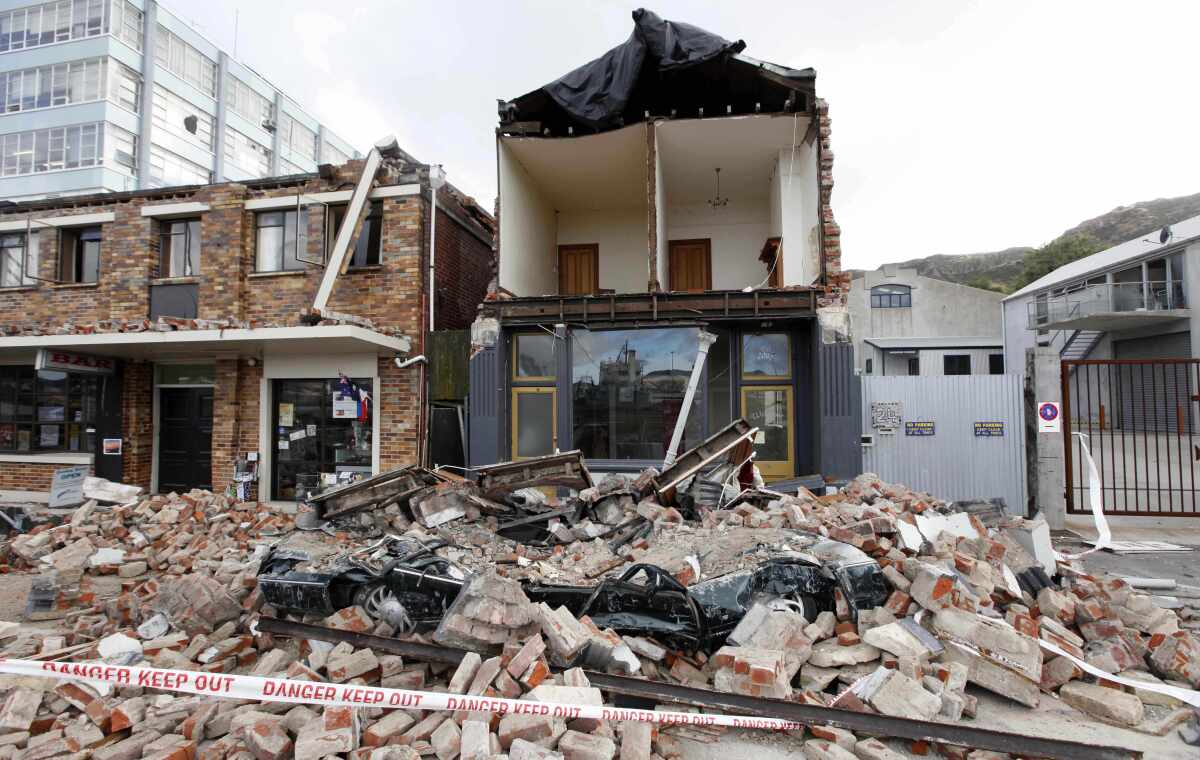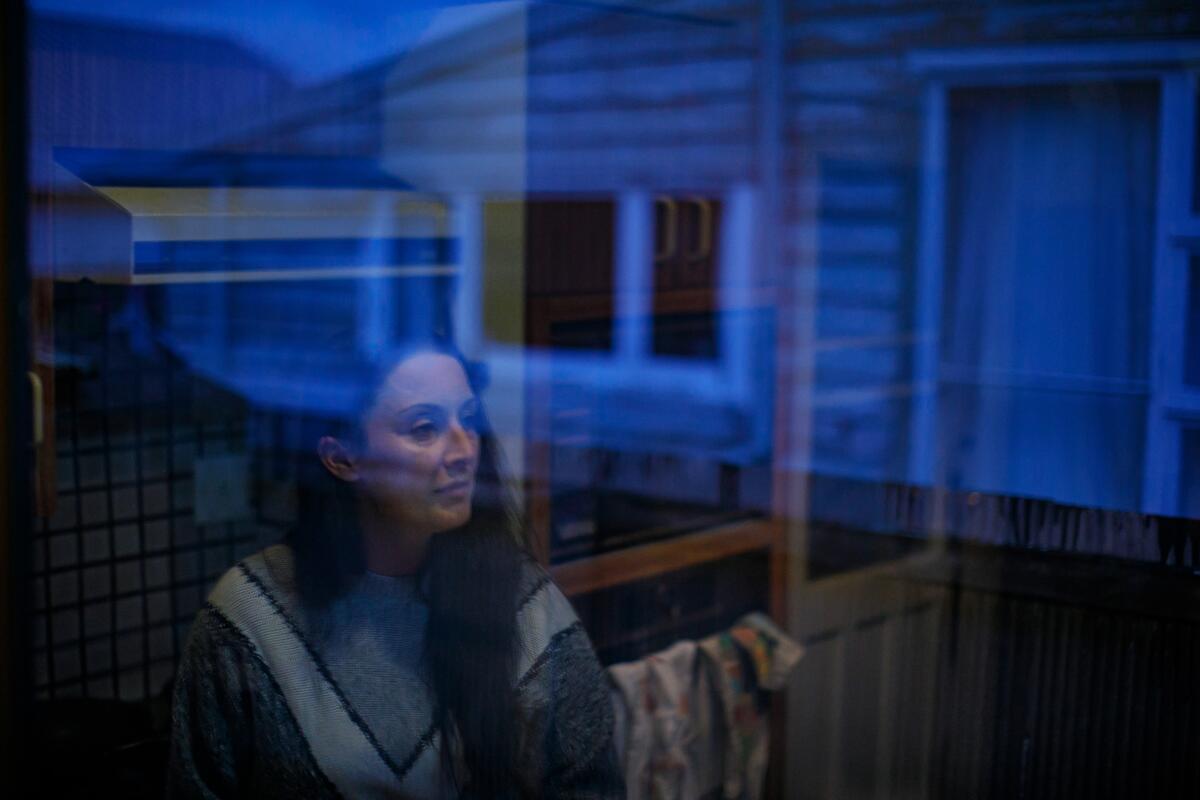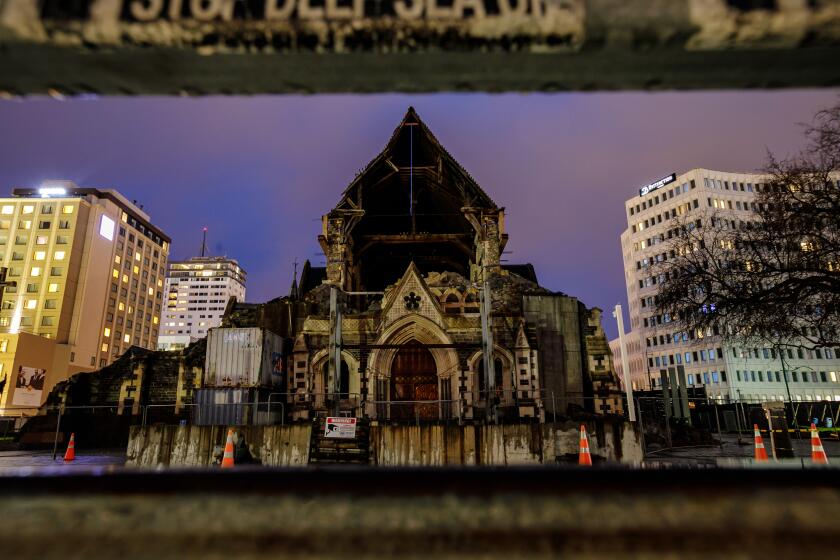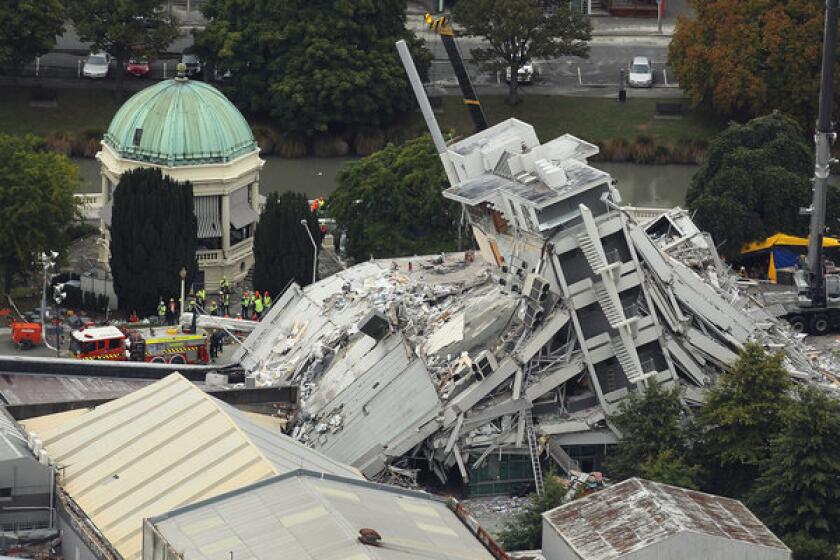I went to New Zealand to understand what a huge California earthquake would look like

- Share via
I went to New Zealand on a long-planned vacation to see the setting for “The Lord of the Rings” movies and the mountain scenery.
But as the earthquake reporter for the Los Angeles Times, I had another goal. I wanted to visit Christchurch, a seaside city on the South Island. For people in the seismic community, there are many lessons California can learn from Christchurch, and I wanted to see it for myself.
On Feb. 22, 2011, a magnitude 6.2 earthquake ruptured right under Christchurch. There have been bigger earthquakes since around the globe that have been more destructive. But Christchurch bears a distinct resemblance to California cities like Los Angeles and San Francisco. We share similar building codes, architectural styles, proximity to major faults, and that familiar denial that comes with living in earthquake country.
So when the sightseeing ended, I spent another week in Christchurch.
I was immediately struck by how much Christchurch had been altered by the quake and how the idea of a “full recovery” was a fantasy. Some voiced optimism of Christchurch being reborn as a safer, and in some ways more vibrant, city; others voiced regret at a lost decade.
The whole story reminded me how, in California and elsewhere, it’s easy to fall into the trap of being too optimistic in the early days after a disaster, where we celebrate heroes and come together as a community and think we can rebuild quickly. That can set up a time of disillusionment and despair, when it becomes clear that rebuilding will be a task that will last a generation or more.
The overall lesson I learned: Be realistic about the challenges the rebuilding will face. It will be far more difficult than anything we might have experienced in our lifetime. And by doing whatever we can before disaster strikes, the easier it will be to recover as best we can.
Here are five lessons I learned from my visit to Christchurch:
1. Recovery will be slower than anyone would like.
Consider the last true catastrophic California quake. The 1906 San Francisco earthquake, estimated to be a magnitude 7.8, caused the collapse of many buildings across the city before sweeping fires destroyed nearly 500 city blocks, turning about 200,000 people — half of the city’s population — homeless. More than 3,000 people died. One study found that the 1906 earthquake stunted cities closest to the worst shaking for decades; they suffered from lower annual population growth continuing at least through 1970.
“People were deciding to not go to places that were hit as hard,” said study coauthor Katherine Eriksson, an assistant professor of economics at UC Davis.
The destruction played a role in halting San Francisco’s run as the undisputed king of the Pacific Coast, which came as Los Angeles gained in prominence.
San Francisco really didn’t fully regain its influence and might until the 1980s, said Ilan Noy, a professor specializing in the economics of disasters at Victoria University in New Zealand. “San Francisco fully recovers only when it develops this new engine of income, which is high-tech,” Noy said.
In Christchurch, progress for the recovery was hampered as officials overpromised and then underfunded rebuilding efforts. “They said everything would be done in five years,” Christchurch City Councilman Raf Manji told me this year before he left office. “They haven’t even started some of the projects — eight years later.”
2. The mental scars can be widespread.
People don’t like to talk about post-traumatic stress, depression and anxiety once the shaking begins. But it’s a major issue.
A year after the 1994 Northridge earthquake, The Times published a poll that showed startling levels of emotional damage from the earthquake.

More than half of those responding to the poll said they and their children continued to suffer from sleeplessness, jittery nerves, fearfulness or other emotional upset. Some said the smallest noises set their anxiety off. “I’m still very nervous and jumpy,” one L.A. resident said. “When my neighbor’s washing machine got off balance the other day, I thought we were having another earthquake.”
Normally, a substantial proportion of post-traumatic mental illness is resolved within one or two years, but that doesn’t always happen; a slow recovery can be particularly taxing for the population.
A study of victims of Hurricane Katrina found that rates of post-traumatic stress disorder rose from 15% to 21% between a period of about half a year to 1½ years after the hurricane; and serious mental illness rose from 11% to 14%.
In the New Orleans metropolitan area about half a year after Katrina hit, about 30% had PTSD; and nearly half had an anxiety mood disorder.
3. The warnings about dangerous buildings are not overblown.
For decades, seismic experts have said certain types of buildings are at high risk of collapse in a major quake. Christchurch proved them right. They include buildings made of brick or stone built in the late 19th and early 20th centuries, as well as more modern concrete buildings, including office towers built through the 1980s.
Just two concrete buildings catastrophically collapsed in the 2011 earthquake, killing 133 people, accounting for more than two-thirds of the death toll in the disaster.
Many brick and stone structures also collapsed, killing more than 40 others. Most were not inside collapsing buildings, but were killed by falling debris while they were outside or in vehicles.
While some big cities like L.A. and San Francisco have pushed to retrofit or demolish brick buildings, a number of smaller California cities have not. Most California cities have not ordered potentially vulnerable concrete buildings to be strengthened, including San Francisco.
4. New Zealand’s recovery was helped by earthquake insurance. California is nowhere near as insured.
California and New Zealand both have tried to tackle seismic safety issues, but Kiwis are well ahead of the Golden State when it comes to insurance.
New Zealand is unusual for its remarkably high earthquake insurance rate. In California, most homeowners are required by their lenders to have only fire insurance. In New Zealand, however, the government created the New Zealand Earthquake Commission, which is a compulsory addendum to anyone with a standard residential fire insurance policy typically required by lenders, Noy said. More than 95% of residential properties have standard fire insurance, and, as a result, are also insured for earthquakes.
The system wasn’t perfect. There have been complaints about how the commission was ill-prepared to manage the massive influx in claims. And some people were under-insured. But the high insurance rate prevented many from losing it all.
If a major quake hit California, homeowners would be much more exposed. Only about 11% of California homeowners have quake insurance.
Small businesses were also helped by a temporary government program in the months after the earthquake.
The government propped up small businesses and their employees with an earthquake support subsidy — keeping paychecks of $320 a week flowing for between six and 14 weeks. About $122 million was spent on the subsidy.
5. Future California earthquakes can be worse than Christchurch’s.
Worst-case earthquakes hitting California’s oldest and largest cities can be far more destructive than what happened in Christchurch in 2011.
While both sit along major tectonic plate boundaries, California is far more populous than New Zealand, and has much more to lose in a big earthquake.
One nightmarish scenario, although not one especially likely to strike in our lifetime, is a magnitude 7 quake on the Puente Hills thrust fault directly underneath a broad swath of central Los Angeles and the San Gabriel Valley. Such a quake could cause the deadliest natural disaster in U.S. history, killing 18,000 people and causing 268,000 injuries.
Likelier scenarios are still catastrophic. According to plausible scenarios studied by the U.S. Geological Survey, a magnitude 7 earthquake on the San Francisco Bay Area’s Hayward fault could lead to 800 deaths and 18,000 injuries.
And a magnitude 7.8 on the San Andreas in Southern California would be a catastrophe, sending severe shaking across Los Angeles, Orange, Riverside, San Bernardino, Kern and Ventura counties, and causing 1,800 deaths and 50,000 injuries. Five steel-frame buildings across Southern California could collapse; and 50 additional brittle concrete buildings could partially or completely collapse.
More to Read
Sign up for Essential California
The most important California stories and recommendations in your inbox every morning.
You may occasionally receive promotional content from the Los Angeles Times.






